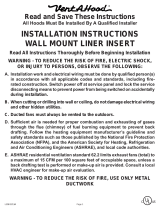
Page 10L023
Hood Cleaning (Continued)
For instances where the blower wheel may need to be removed,
follow the instructions below.
Removing the blower wheel requires a 1/8” hex wrench. A 1/8” hex
wrench may be obtained from your local hardware store or directly
from your local Vent-A-Hood
®
dealer. There is a small set screw
on the side of the hub of the wheel (A) that tightens up against a
“at” spot on the motor shaft. The set screw must be turned ½ turn
counterclockwise to remove the blower wheel. Insert wrench through
the blades of the blower wheel and into the set screw. If the wheel
is dicult to remove, the area where the motor shaft makes contact
with the blower wheel hub may need to be sprayed with a common
penetrating oil such as WD-40
®
.
After allowing the penetrating oil to soak for a few minutes, push
the blower wheel forward slightly, then gently pull the blower wheel
o the motor shaft. Use caution to avoid bending or distorting the
blower wheel and take care not to move or lose the metal balancing
clips that may be axed to the wheel (B).
A soft bristle toothbrush with warm soapy water may be used to clean
the blades, or soak the blower wheel in warm soapy water. When
reinstalling the wheel onto the motor shaft, make sure the set screw
makes direct contact with the “at spot” on the motor shaft. Slide
the blower wheel onto the motor shaft as far as it will go, making
sure the back of the blower wheel does not touch the motor mount
screws protruding from the motor.
If the motor is too far back, it will rub the motor mount screws, and if
it is too far forward, it will rub the inside of the blower housing. Adjust
the blower wheel slightly to nd the correct front-to-rear location.
Tighten the set screw (clockwise) to lock the blower wheel in the
correct position.
NOTE: For hoods that have more than one blower wheel, make sure
that white blower wheels are matched up with white motor rings,
and black blower wheels are matched up with black motor rings.
The hood will not perform properly if blower wheels and motors are
mismatched.
















